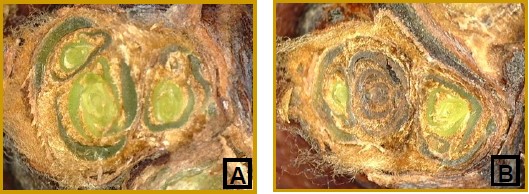Vinews
No. 01 — Jan. 23, 2023
Contents:
Show Me Grape and Wine Conference and Symposium
Show Me Grape and Wine Conference and Symposium:
March 1-2, 2023
Beginner Grape School:
March 3, 2023
Registration is open for both these events. Registration deadline is Feb. 21.
Book your hotel by Feb. 5 for the discounted rate. See more information on our conference page
topAssess Bud Survival Prior to Pruning

An extended cold-climatic event occurred in late December 2022. Average air temperatures were below 0 degrees F for 24 hours starting on Dec. 22 (Figure 1). This event will have an impact on the 2023 crop depending on how you manage your grapevines going forward. Anytime when air temperatures fall below 0 degrees F during the dormant season the count-buds of grapevines should be evaluated prior to dormant pruning (Figure 2). This information can then be used to modify the number of count-buds to leave per grapevine. Understandably, some vineyards may have been pruned prior to this cold period. These vineyards should also be evaluated for bud health. An example of a cultivar that is often pruned early is Norton. Bud damage to early pruned grape cultivars provides you information on crop loss. As an example, 50% primary count-bud death of Norton provides an indication of 50% yield loss since Norton seldom fruits from secondary buds. This information can then be used to potentially source grapes from other local growers.

There was a lot of variability in primary bud damage between cultivars and among different vineyards of Norton (Table 1). This variability tells us that it is very important to evaluate bud damage of each cultivar and each vineyard block.
| Cultivar1 | Dead primary buds (%) |
Dead secondary buds (%) |
|---|---|---|
| Chambourcin | 63 | NA2 |
| Chardonel | 60 | NA |
| Concord | 40 | 13 |
| Norton vineyard 1 | 12 | NA |
| Norton vineyard 2 | 21 | NA |
| Norton vineyard 3 | 45 | NA |
| Vidal blanc | 76 | NA |
| Vignoles | 25 | NA | Average | 43 | 9 |
1 A total of 10 canes with 5 to 6 buds per cane were evaluated per cultivar.
2 NA represents that secondary buds were not evaluated.
How to Evaluate Grape Buds
See the GWI article Determinging Cold-Injury to Grape Buds
topIf you would like more information on IPM in grapes, please contact Dean Volenberg at 573-882-0476 (office) 573-473-0374 (mobile) or volenbergd@missouri.edu
top